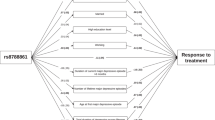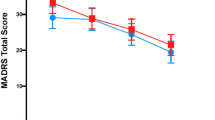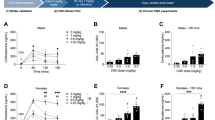Abstract
The most consistent biological findings in patients with depression are abnormalities in the hypothalamic–pituitary–adrenal (HPA)-axis, which can be measured using the combined dexamethasone-suppression/CRH-stimulation (Dex-CRH) test. The reactivity of the HPA-axis in this test, however, ranges over several orders of magnitude in depressed patients with comparable severity of symptoms. In this present study, we investigate which factors influence the magnitude of the response in the Dex-CRH test in 235 acutely depressed in-patients. We first examined the effects of common confounders shown to influence the HPA-axis, such as caffeine and nicotine consumption, acute stressors during the test, weight, gender, and age. Of all these variables, only female sex and nicotine consumption were positively correlated with the cortisol or ACTH response, respectively. As for the effects of psychopharmacological treatment, only the intake of carbamazepine and the fact of having relapsed under an established pharmacotherapy significantly increased the response in the Dex-CRH test, whereas the presence or absence of antidepressant treatment, the type of antidepressant treatment, or the number of ineffective antidepressant treatment trials during the index episode up to admission did not have any effect. We also found a positive correlation of the number of previous episodes, the overall HAM-D score and the severity of somatic/vegetative symptoms with the results in the Dex-CRH test. These results underline that in depressed patients this test is not majorly influenced by disease-unrelated factors. In addition, current antidepressant treatment does not appear to affect test outcome in the absence of clinical response. The influence of the number of previous episodes and relapse under pharmacotherapy suggests that HPA-axis reactivity may be altered by repetitive states of hypercortisolemia or continuous antidepressant treatment. Finally, more severe vegetative symptoms are associated with an enhanced HPA-axis activity.
Similar content being viewed by others
Log in or create a free account to read this content
Gain free access to this article, as well as selected content from this journal and more on nature.com
or
References
Almasy L, Blangero J (2001). Endophenotypes as quantitative risk factors for psychiatric disease: rationale and study design. Am J Med Genet 105: 42–44.
Baghai TC, Schule C, Zwanzger P, Minov C, Zill P, Ella R et al (2002). Hypothalamic–pituitary–adrenocortical axis dysregulation in patients with major depression is influenced by the insertion/deletion polymorphism in the angiotensin I-converting enzyme gene. Neurosci Lett 328: 299–303.
Bryer JB, Borrelli DJ, Matthews Jr EJ, Kornetsky C (1985). The dexamethasone suppression test in depression: some correlates. Biol Psychiatry 20: 814–815.
Bschor T, Adli M, Baethge C, Eichmann U, Ising M, Uhr M et al (2002). Lithium augmentation increases the ACTH and cortisol response in the combined DEX/CRH test in unipolar major depression. Neuropsychopharmacology 27: 470–478.
Casanueva FF, Dieguez C (1999). Neuroendocrine regulation and actions of leptin. Front Neuroendocrinol 20: 317–363.
Davis KL, Davis BM, Mathe AA et al (1984). Age and the dexamethasone suppression test in depression. Am J Psychiatry 141: 872–874.
Faloia E, Camilloni MA, Giacchetti G, Mantero F (2000). Adipose tissue as an endocrine organ? A review of some recent data. Eat Weight Disord 5: 116–123.
Frederick SL, Reus VI, Ginsberg D, Hall SM, Munoz RF, Ellman G (1998). Cortisol and response to dexamethasone as predictors of withdrawal distress and abstinence success in smokers. Biol Psychiatry 43: 525–530.
Gold PW, Loriaux DL, Roy A, Kling MA, Calabrese JR, Kellner CH et al (1986). Responses to corticotropin-releasing hormone in the hypercortisolism of depression and Cushing's disease. Pathophysiologic and diagnostic implications. N Engl J Med 314: 1329–1335.
Guthrie S (1991). The impact of dexamethasone pharmacokinetics on the DST: a review. Psychopharmacol Bull 27: 565–576.
Habib KE, Gold PW, Chrousos GP (2001). Neuroendocrinology of stress. Endocrinol Metab Clin N Am 30: 695–728; vii–viii.
Halbreich U, Asnis GM, Shindledecker R, Zumoff B, Nathan RS (1985). Cortisol secretion in endogenous depression. I. Basal plasma levels. Arch Gen Psychiatry 42: 904–908.
Handa RJ, Burgess LH, Kerr JE, O'Keefe JA (1994). Gonadal steroid hormone receptors and sex differences in the hypothalamo-pituitary-adrenal axis. Horm Behav 28: 464–476.
Hatzinger M, Hemmeter UM, Baumann K, Brand S, Holsboer-Trachsler E (2002). The combined DEX-CRH test in treatment course and long-term outcome of major depression. J Psychiatr Res 36: 287–297.
Hatzinger M, Wotjak CT, Naruo T et al (2000). Endogenous vasopressin contributes to hypothalamic–pituitary–adrenocortical alterations in aged rats. J Endocrinol 164: 197–205.
Heuser IJ, Gotthardt U, Schweiger U et al (1994a). Age-associated changes of pituitary–adrenocortical hormone regulation in humans: importance of gender. Neurobiol Aging 15: 227–231.
Heuser I, Yassouridis A, Holsboer F (1994b). The combined dexamethasone/CRH test: a refined laboratory test for psychiatric disorders. J Psychiatr Res 28: 341–356.
Heuser IJ, Schweiger U, Gotthardt U et al (1996). Pituitary–adrenal-system regulation and psychopathology during amitriptyline treatment in elderly depressed patients and normal comparison subjects. Am J Psychiatry 153: 93–99.
Holm S (1979). A simple sequentially rejective multiple test procedure. Scand J Stat 6: 65–70.
Holsboer F (1999). The rationale for corticotropin-releasing hormone receptor (CRH-R) antagonists to treat depression and anxiety. J Psychiatr Res 33: 181–214.
Holsboer F (2000). The corticosteroid receptor hypothesis of depression. Neuropsychopharmacology 23: 477–501.
Holsboer F, von Bardeleben U, Gerken A, Stalla GK, Muller OA (1984). Blunted corticotropin and normal cortisol response to human corticotropin-releasing factor in depression. N Engl J Med 311: 1127.
Holsboer F, von Bardeleben U, Wiedemann K, Muller OA, Stalla GK (1987). Serial assessment of corticotropin-releasing hormone response after dexamethasone in depression. Implications for pathophysiology of DST nonsuppression. Biol Psychiatry 22: 228–234.
Holsboer F, Barden N (1996). Antidepressants and hypothalamic–pituitary–adrenocortical regulation. Endocr Rev 17: 187–205.
Holsboer F, Lauer CJ, Schreiber W, Krieg JC (1995). Altered hypothalamic–pituitary–adrenocortical regulation in healthy subjects at high familial risk for affective disorders. Neuroendocrinology 62: 340–347.
Holsboer-Trachsler E, Buol C, Wiedemann K, Holsboer F (1987). Dexamethasone suppression test in severe schizophrenic illness: effects of plasma dexamethasone and caffeine levels. Acta Psychiatr Scand 75: 608–613.
Holsboer-Trachsler E, Stohler R, Hatzinger M (1991). Repeated administration of the combined dexamethasone–human corticotropin releasing hormone stimulation test during treatment of depression. Psychiatry Res 38: 163–171.
Isgor C, Shieh KR, Akil H, Watson SJ (2003). Colocalization of estrogen beta-receptor messenger RNA with orphanin FQ, vasopressin and oxytocin in the rat hypothalamic paraventricular and supraoptic nuclei. Anat Embryol 11: 11.
Kagoshima M, Wilcke T, Ito K et al (2001). Glucocorticoid-mediated transrepression is regulated by histone acetylation and DNA methylation. Eur J Pharmacol 429: 327–334.
Kalin NH, Shelton SE, Kraemer GW, McKinney WT (1983). Corticotropin-releasing factor administered intraventricularly to rhesus monkeys. Peptides 4: 217–220.
Keck ME, Hatzinger M, Wotjak CT, Landgraf R, Holsboer F, Neumann ID (2000). Ageing alters intrahypothalamic release patterns of vasopressin and oxytocin in rats. Eur J Neurosci 12: 1487–1494.
Magiakou MA, Mastorakos G, Webster E, Chrousos GP (1997). The hypothalamic–pituitary–adrenal axis and the female reproductive system. Ann N Y Acad Sci 816: 42–56.
Matta SG, Fu Y, Valentine JD, Sharp BM (1998). Response of the hypothalamo-pituitary-adrenal axis to nicotine. Psychoneuroendocrinology 23: 103–113.
Miller DB, O'Callaghan JP (2002). Neuroendocrine aspects of the response to stress. Metabolism 51: 5–10.
Mitchell AJ (1998). The role of corticotropin releasing factor in depressive illness: a critical review. Neurosci Biobehav Rev 22: 635–651.
Modell S, Yassouridis A, Huber J, Holsboer F (1997). Corticosteroid receptor function is decreased in depressed patients. Neuroendocrinology 65: 216–222.
Nelson JC, Davis JM (1997). DST studies in psychotic depression: a meta-analysis. Am J Psychiatry 154: 1497–1503.
Nemeroff CB, Owens MJ, Bissette G, Andorn AC, Stanley M (1988). Reduced corticotropin releasing factor binding sites in the frontal cortex of suicide victims. Arch Gen Psychiatry 45: 577–579.
Nemeroff CB, Widerlov E, Bissette G et al (1984). Elevated concentrations of CSF corticotropin-releasing factor-like immunoreactivity in depressed patients. Science 226: 1342–1344.
Nicholson SA (1989). Stimulatory effect of caffeine on the hypothalamo-pituitary-adrenocortical axis in the rat. J Endocrinol 122: 535–543.
Nicholson SA, Campbell EA, Gillham B, Jones MT (1987). Recovery of the components of the hypothalamo-pituitary-adrenocortical axis in the rat after chronic treatment with prednisolone. J Endocrinol 113: 239–247.
Nickel T, Sonntag A, Schill J, Zobel AW, Ackl N, Brunnauer A et al (2003). Clinical and neurobiological effects of tianeptine and paroxetine in major depression. J Clin Psychopharmacol 23: 155–168.
Oshima A, Miyano H, Yamashita S et al (2001). Psychological, autonomic and neuroendocrine responses to acute stressors in the combined dexamethasone/CRH test: a study in healthy subjects. J Psychiatr Res 35: 95–104.
Overall JE, Rhoades HM (1982). Use of the Hamilton Rating Scale for classification of depressive disorders. Compr Psychiatry 23: 370–376.
Owens MJ, Nemeroff CB (1991). Physiology and pharmacology of corticotropin-releasing factor. Pharmacol Rev 43: 425–473.
Pariante CM, Hye A, Williamson R, Makoff A, Lovestone S, Kerwin RW (2003). The antidepressant clomipramine regulates cortisol intracellular concentrations and glucocorticiod receptor expression in fibroblasts and rat primary neurones. Neuropsychopharmacology 10: 1553–1561.
Pickworth WB, Baumann MH, Fant RV, Rothman RB, Henningfield JE (1996). Endocrine responses during acute nicotine withdrawal. Pharmacol Biochem Behav 55: 433–437.
Posener JA, DeBattista C, Williams GH, Chmura Kraemer H, Kalehzan BM, Schatzberg AF (2000). 24-Hour monitoring of cortisol and corticotropin secretion in psychotic and nonpsychotic major depression. Arch Gen Psychiatry 57: 755–760.
Raadsheer FC, Hoogendijk WJ, Stam FC, Tilders FJ, Swaab DF (1994). Increased numbers of corticotropin-releasing hormone expressing neurons in the hypothalamic paraventricular nucleus of depressed patients. Neuroendocrinology 60: 436–444.
Rhodes ME, O'Toole SM, Czambel RK, Rubin RT (2001). Male–female differences in rat hypothalamic–pituitary–adrenal axis responses to nicotine stimulation. Brain Res Bull 54: 681–688.
Rybakowski JK, Twardowska K (1999). The dexamethasone/corticotropin-releasing hormone test in depression in bipolar and unipolar affective illness. J Psychiatr Res 33: 363–370.
Stokes PE, Stoll PM, Koslow SH et al (1984). Pretreatment DST and hypothalamic–pituitary–adrenocortical function in depressed patients and comparison groups. A multicenter study. Arch Gen Psychiatry 41: 257–267.
Swaab DF (1995). Ageing of the human hypothalamus. Horm Res 43: 8–11.
Thomassin H, Flavin M, Espinas ML, Grange T (2001). Glucocorticoid-induced DNA demethylation and gene memory during development. EMBO J 20: 1974–1983.
Uhr M, Grauer MT (2003). abcb1ab P-glycoprotein is involved in the uptake of citalopram and trimipramine into the brain of mice. J Psychiatr Res 37: 179–185.
Uhr M, Steckler T, Yassouridis A, Holsboer F (2000). Penetration of amitriptyline, but not of fluoxetine, into brain is enhanced in mice with blood–brain barrier deficiency due to mdr1a P-glycoprotein gene disruption. Neuropsychopharmacology 22: 380–387.
von Bardeleben U, Holsboer F (1991). Effect of age on the cortisol response to human corticotropin-releasing hormone in depressed patients pretreated with dexamethasone. Biol Psychiatry 29: 1042–1050.
von Bardeleben U, Wiedemann K, Stalla GK, Muller OA, Holsboer F (1988). Exaggerated corticotrophic cell response to human corticotropin-releasing hormone in two patients during long-term carbamazepine treatment. Biol Psychiatry 24: 331–335.
Wang PW, Ketter TA (2002). Pharmacokinetics of mood stabilizers and new anticonvulsants. Psychopharmacol Bull 36: 44–66.
Wittchen HU, Knauper B, Kessler RC (1994). Lifetime risk of depression. Br J Psychiatry 26(Suppl): 16–22.
Zobel AW, Nickel T, Sonntag A, Uhr M, Holsboer F, Ising M (2001). Cortisol response in the combined dexamethasone/CRH test as predictor of relapse in patients with remitted depression. A prospective study. J Psychiatr Res 35: 83–94.
Zobel AW, Yassouridis A, Frieboes RM, Holsboer F (1999). Prediction of medium-term outcome by cortisol response to the combined dexamethasone–CRH test in patients with remitted depression. Am J Psychiatry 156: 949–951.
Author information
Authors and Affiliations
Corresponding author
Rights and permissions
About this article
Cite this article
Künzel, H., Binder, E., Nickel, T. et al. Pharmacological and Nonpharmacological Factors Influencing Hypothalamic–Pituitary–Adrenocortical Axis Reactivity in Acutely Depressed Psychiatric In-patients, Measured by the Dex-CRH Test. Neuropsychopharmacol 28, 2169–2178 (2003). https://doi.org/10.1038/sj.npp.1300280
Received:
Revised:
Accepted:
Published:
Issue date:
DOI: https://doi.org/10.1038/sj.npp.1300280
Keywords
This article is cited by
-
HPA axis reactivity to pharmacologic and psychological stressors in euthymic women with histories of postpartum versus major depression
Archives of Women's Mental Health (2017)
-
Clinical application of DEX/CRH test and multi-channel NIRS in patients with depression
Behavioral and Brain Functions (2016)
-
Dexamethasone Stimulated Gene Expression in Peripheral Blood is a Sensitive Marker for Glucocorticoid Receptor Resistance in Depressed Patients
Neuropsychopharmacology (2012)
-
Reliability of hypothalamic–pituitary–adrenal axis assessment methods for use in population-based studies
European Journal of Epidemiology (2011)
-
Atypical depression is more common than melancholic in fibromyalgia: an observational cohort study
BMC Musculoskeletal Disorders (2010)



